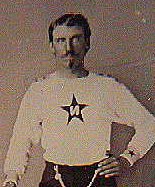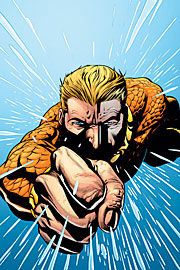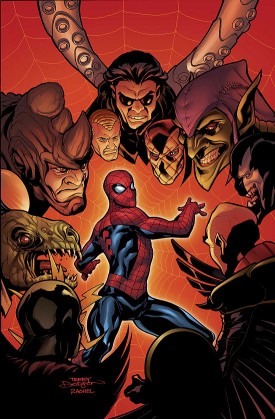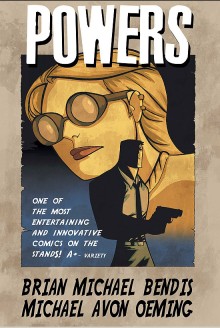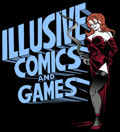|
|
|
|
Jason
Schachat vowed revenge on the clown that killed
his dad.
|
Jason
Schachat's Independent Breakdown
December 10, 2004
Each
week, Jason Schachat takes you along for his ride on the
four-colored pulp pony. Feed the addiction, and the addiction
feeds you.
I read the news today. Oh, boy…
The
Flash movie adaptation is slated to be directed by David
Goyer and star Ryan Reynolds. If these web rumors are true
(bwahahahaha!), I get the feeling Warner will be re-thinking
things in the wake of Blade:
Trinity.
Usually,
I join Derek in supporting industry whipping-boy Chuck Austen’s
run on Action Comics, but I have to pass on this
issue. The Lana/Clark/Lois love triangle is annoying enough
in its own right, but the desertions of the Preus plot (racist
Kandor cop gone amuck, not the Toyota hybrid), Doomsday’s
rampaging, and the continued meddlings of Gog are just nonsensical.
Summary
of Action Comics #822: Clark learns
that Jimmy Olsen, not Jack Ryder, took his job. Lois finds
another woman’s panties in their apartment, they pack
up and go for a visit to Ma and Pa Kent, and, in the ONE
thread from last issue that weaves in, the repo-man Gog
“gifted” hulks-out and goes on a rampage.
Lotta rampaging.
So, just to keep the chronology straight,
Preus appears while Doomsday causes a citywide evacuation
of Metropolis, then takes out Martian Manhunter while Supes
is glued to Lois’ bedside… and now everything’s
magically better? The last issue ended with a damn “to
be continued…” and NOW we just dive into “Repo-Man
part one” without any explanation of what happened
to Manhunter, how Doomsday was stopped, or whether Preus
is still taking over the world or not?!?!
I’m sorry, but this is going too far.
It’s one thing to mess up the continuity on crossovers
and references to old runs, but to be THIS poorly thought
out from one issue to another is criminal. It’s SO
out there, it overshadows the meathead characterization
of Supes in this issue and the question of what the hell
kinda kryptonite turns scrawny geeks into Jason Giambi.
There’s still a chance for Chuckles
to flashback and tell us how the last few conflicts were
resolved, but that’s sloppy writing and everyone knows
it. Avoid this issue like the plague and give up any hope
that Austen will pull his threads together with any coherence
or efficiency. I may be going out on a limb here, but this
could be the worst Superman story of the year.
On another
book that explained awkward events through flashback, Aquaman
#25 gets half a new team as Patrick Gleason
returns to the drawing board and John Arcudi takes over
writing chores after John Ostrander’s two-issue arc.
So, what’s the word on the sunken streets? Drugs!
(You may roll your eyes… now.) Yes, the first story
from the new team finds Aquaman battling a submarine smack
dealer in the struggle to bring harmony to Sub Diego.
Arthur and girl-friday Lorena cruise around
the waves in a rare time of relaxation, but that’s
quickly disturbed when they spot a scavenging frogman with
a bag full of loot. They interrogate him best as one can
underwater, and he points them to a playground where respectable
citizens are frolicking like children as empty vials and
syringes float in their wake.
It’s not long before we find out someone’s
peddling narcotics on Aquaman’s turf. But what can
he do when the people of Sub Diego live in such doldrums?
And what will he do when he tracks down the dealer and his
gang of sharp-toothed henchmen?
Last time I reviewed this book, my big complaint
was we kept seeing the same old thing. If it’s underwater
warfare, we’ve most likely seen it already. If it’s
standard eco-terrorism, that’s nothing new. And, yeah,
I’m sorry to say it, but fighting drug dealers doesn’t
suddenly freshen up because it takes place underwater.
I’ll give Arcudi credit for trying
to throw some science and common sense our way, but when
homeless people file their pearly whites down and suddenly
have teeth like sharks, you’re not on grounds where
science reigns supreme. Heck, when malnourished people in
trenchcoats are zipping around underwater like speed force-wielding
dolphins, you KNOW logic has been thrown out the window.
But then, Aquaman never was a character
built on logic, and you’d have a difficult time changing
that. So, you should probably make his story as fantastic
as possible. The sinking of San Diego? Fantastic notion!
But underwater drug dealer? If not for the air bubbles and
murky backgrounds, this could be a Bat-book. Next month
sees a new arc begin, so new and old readers shouldn’t
regret missing out on this standalone issue. Pass.
|
|
|
Jason
Schachat vowed revenge on the clown that killed
his dad.
|
I have
many regrets about Demo, but none come from reading
it. I regret not having read all of these oneshots. I regret
not having caught on to them earlier. And, most of all,
I regret that Demo #12 will be
the first and last part of the series I get to review.
I never
followed any of the press releases or other reviews that
have been written through the last year, but the linking
theme has been much like the concept behind DC’s failed
Focus line: Superpowers, but not superheroes. Only Demo
does it right. The stories take very simple, honest approaches
to the amazing powers and struggles of the characters and
never once make you think people are going to don tights
and cackling villains.
The final issue divides its efforts between
two love stories: One poetic and airy, the other darkly
comforting. “Mon Dernier Jour Avec Toi (My Last Night
With You)” sings a song of tender, perfect love, following
a young couple through a day and night in Brooklyn that
will be their last, yet never ends.
“Marie & Mike” revisits
the couple from the very first issue (“NYC”),
finding them living not necessarily happily ever after,
yet well enough. Marie’s headaches continue, and the
world looks as harsh and unforgiving as ever, but they’re
together, they’re getting by, and they’re fine
being “different”. The series comes full circle;
loyal readers will take a calm breath and smile.
Maybe
I haven’t been giving writer Brian Wood his due (hey,
the guy wrote a Vampirella/Witchblade book; that
doesn’t exactly scream “revolutionary”),
but I’m definitely going to take a closer look into
his work, as well as that of artist Becky Cloonan. The chapters
of Demo have been more diverse than any run I can
remember coming across, and the appeal has never faded.
These stories aren’t just designed
for the superhero-filled racks of the comic shops; they
could easily fit amongst the novels at any bookstore. Demo
never attempts to alienate readers with convoluted continuity
or notions that belong in an alternate reality: this is
the supernatural come to our world. And, in a bold move
for the comic medium, it’s moving and original.
That
said, this probably isn’t the best place to start.
This last issue gives us quiet love stories, and that’s
just not the best way to head into a series that’s
been so exciting, scary, and outspoken in its other issues.
If anything, I’d recommend you go back and collect
the rest of the series first (I know I will) before grabbing
this. But, if you need just a little taste to get you started,
buy any copy of Demo you can find. Definitely recommended.
You
know the one thing you have to love about Marvel Age
Hulk? You really CAN hop on any time. If there was
one thing that made comics too much of a burden to follow,
it was the never-ending plotlines that wouldn’t give
you a good point to leave the series. Sure, that strategy
kept you reading, but it also insured you never came back
after you broke free.
Marvel
Age Hulk #4 dumps us into the middle of a
TV broadcast showing a giant green monster rampaging through
Texas. While the citizens of Pecos aren’t particularly
happy about this, Bruce Banner is even more upset. You see,
he’s never been to Texas. He takes the first bus he
can find to Pecos and examines the scene, finding that the
monster left a calling card for Banner to follow. One that
tells him it’s his former lab assistant Emil at work.
Bruce tracks the monstrous footprints to
a cave and, sure enough, finds Emil transformed into a gamma
ray gargantua. But how? Banner destroyed all his research
before becoming a fugitive. All except what Emil learned
watching his old master, that is. Yes, the bosses wanted
him to recreate the project, and Emil did that to a ‘t’.
But now he wants to be changed back, and he’ll beat
Banner to a pulp if that’s what it takes to get a
cure out of him.
Uh oh… Hulk no like that…
All you need to know going into this is
that Bruce Banner does a Jekyll & Hyde when he gets
angry and stays on the run so he won’t hurt anybody/can
find a cure. No intelligent Hulk, cousins needing blood
transfusions, superteams, interdimensional conflicts, or
sudden shifts in skin pigmentation; this is the Hulk, plain
and simple.
Does it have the depth which Stan Lee and
Jack Kirby’s creation reached? No, it’s a simple
comic for all ages. And it’s fine that way. In the
end, most of the appeal of the character was just hearing
him say “HULK SMASH!” and then watching cars
get tossed through the air. In that respect, I think writer
Mike Raicht could fit some more humor into the story, giving
adults more reason to read it, and Ryan Odagawa’s
pencils don’t really work for me, but it’s still
a good book for the kids.
If nothing else, it gives them an adventure
their weekly allowances can afford that won’t force
them to become comic crackfiends like the rest of us. (RUN,
CHILDREN! RUN!!!) It doesn’t really cut the mustard
for those of us who demand more of graphic narrative, but
I can definitely recommend it as a stocking stuffer or reading
material for that long ride to gramma’s.
|
|
|
Spidey's
in the mush pot...
|
As one
who does demand more of graphic narrative, I may not be
fond of Mark Millar’s recent work on Ultimates,
but that won’t keep me from saying that Marvel
Knights Spider-Man #9 rocks. Set up to be
the final arc in the series (at least, as far as we can
tell), “The Last Stand” opens with some heartfelt
characterization and then dives into one of the coolest
quasi-revelations we’ve had in a while.
We flashback to a time when young Peter
Parker still had Uncle Ben’s shoulder to cry on, and
the thought that he would lose his surrogate parents so
quickly due to their advanced age is enough to drive the
poor boy to tears. But then we remember the more violent
end that snatched Ben away. And the one that befell Gwen
Stacy. Then Peter remembers the laundry list of friends
and loved ones he’s had to bury over the years…
And how he won’t let the same happen
to Aunt May.
On his morning jog, Parker gets a surprise
visit from an out-of-costume Scorpion and finally finds
himself face to face with May’s kidnapper. However,
it turns out that Spidey’s own actions are what caused
the torment of the last year: Norman Osborn always had a
contingency plan set up if he should run into trouble (yes,
one that doesn’t involve genetically enhanced twin
offspring taking up his mantle).
Scorpion then launches into a minor history
and examination of the role of supervillains that would
be the stuff of any tired comic book encyclopedia if not
for the fact that it’s so damn entertaining. These
are the kind of logical scrutinies that open readers’
eyes to a whole new dimension of meaning. They’re
the kind of common sense notions we forget all the time,
but just saying the words invokes a powerful spell. It’s
something Millar does well (when he does it at all), and
you’ve gotta love him for it.
Having been down this road before, I’m
not holding my breath in the hopes that this arc will end
with the same panache it kicks off with, but this is an
issue ANYONE can dive into and get a lot out of. It’s
also the best thing Millar’s put out in quite a while.
Strongly recommended.
Sensing
that it was time for another big team-up, the folks at Marvel
give us X4 #1 (aka X-Men/Fantastic
Four #1) this week. Bringing in a crew from Dreamwave
Studios (the same people who made Transformers cool again),
Pat Lee and Akira Yoshida put all their ingenuity into a
story that… that… well, seems to be doing the
same old thing all over again.
Things kick off with a space shuttle on
a return trip from Mars docking at a big ol’ space
station. Then it blows up. Or, rather, part of it blows
up. The Fantastic Four then rudely awaken Wolverine the
next morning when they come to speak with Xavier. Of course,
they don’t know Xavier isn’t around any more,
but that doesn’t stop little misunderstandings from
erupting into the big obligatory team vs. team fight.
Emma Frost chills everybody out long enough
to get them to discuss what the Fantastic Four want, and
we hear another telling of the space station incident. Apparently,
communications are down and they want a telepath to scan
and see if anyone’s alive up there. No dice, but the
X-men DO have a space-worthy craft in the garage. The catch:
it only has enough seats for six, and more than two X-men
are coming along.
That’s right: it’s a collision
course for wackiness!
Honestly, I don’t see what the thought
process here is. When they pick the team, all the “energy-emitting”
people get benched so they can avoid hull breaches. Oh,
but Wolvie, Thing, and Gambit are okay ‘cause they’re
“resourceful” “heavy hitters”. And
since when can the Fantastic Four not get into space on
their own? This is Reed frikkin’ Richards here! He
could make a Klingon Battlecruiser out of old beer cans
and pipecleaners, but noooooo; they need to borrow the X-Jet!
And what they find when they get up there…
oy. The art was a little unclear for me to be positive,
but I should’ve known better than to expect NEW threats
to suddenly come to us from Mars. If the rest of this mini
is anything— and I mean ANYTHING like the first part,
you’ve seen it before, and you’ve seen it done
better.
I’ve
never been a fan of Pat Lee’s art and this is no exception,
but I do have to give the Dreamwave crew some credit. The
combined efforts still don’t make the characters work
for me, but there’s some nice production to be found
and the inanimate objects look very nice, indeed. Especially
the opening sequence with the shuttle. I’d still rather
stare at the pretty pictures in an issue of Transformers,
though. Not recommended.
|
|
|
Did
we mention we're mentioned?
|
Requested
Review of the Week
RAM
wrote in again to tell us about some of the books he’s
been following and one of the titles he brought up was Powers.
Yeah, yeah; that’s pushing the definitions of “request”,
but, considering that I didn’t intend to review it
this month AND we got a plug in the letters column, I’m
bumping it up to the top!
But
I’m not the only shill here, as Bendis uses Powers
#7 to not only kick off a new story arc but
also work in new character Geoffrey Johns of the law firm
Johns, Winick, Brubaker, and Meltzer (aka DC’s hot
writers) and has some cops call officers Hine and Kirkman
for backup (aka Marvel’s hot young writers). Oh, and
it’s hard to read, but there’s a license plate
that says Chakin (aka… well, you should know who Howard
Chaykin is by now, kids). But this has become a tradition
on Powers, so we can’t really complain.
Detective Walker gives some sagely advice
to the new Retro Girl after she successfully but messily
dispatches with yet another superpowered petty crook on
the rampage: Mainly, it comes down to how you intimidate
while keeping your spandex-clad goodies from getting gawked
at on TV.
We then rush off to the murder scene of
Blackguard, a hero considered retired well before superpowers
were declared illegal. What’s truly odd is that neighbors
report he was fighting The Joke, a villain who’d have
to be on social security by now. And there’s a “Shadow
Man” involved too? What about this isn’t adding
up?
The
main reason I avoided reviewing Powers for so long
was I found myself predicting everything that was happening.
When Chris Garcia first introduced me to this series, I
instantly looked at the image of Walker standing next to
swat cops and said “Oh, he’s a retired hero”.
With the restart, I predicted what would happen in issues
#3 (history/nature of Retro Girl) and #5 (Power Deena) and
started feeling the same lack of momentum that dragged the
first volume’s beginning down.
But I’ll give Bendis credit on this
one: the storytelling’s sharp and involving, and I’m
back to a point where I can’t say what’ll happen
next (my favorite place to be). Volume two had a comparatively
quiet start after the epic events of the two prior arcs,
but we can see the creators were simply trying to make it
easy for new readers to get involved. The lack of complexity
was there for the same reason it was in the beginning last
time around.
But, just as ‘Who Killed Retro Girl?”
gave way to “Roleplay” and the “Groupies”
arc that got me hooked for good, so, it seems, will this
new arc move us back toward the intricacies that make this
title sing. And, hey, maybe we’ll see if Bendis can
keep an original storyline going beyond thirty some-odd
issues…
Kidding!
Just kidding! We love Bendis, as our forums no doubt show,
so head over there if you wanna see more Bendis lovin’
and, oh, maybe tell
us what comics YOU want to see us review.
|
